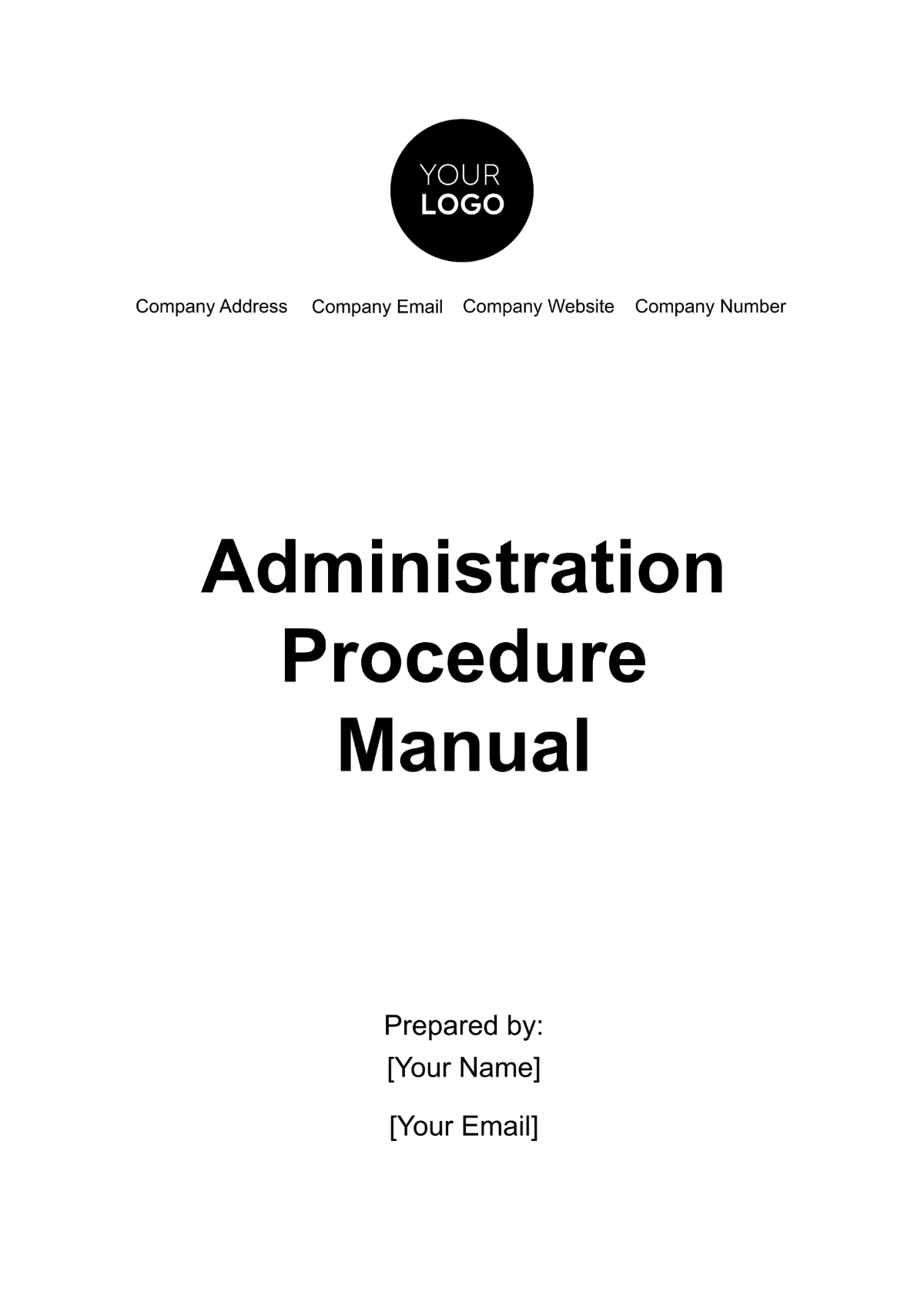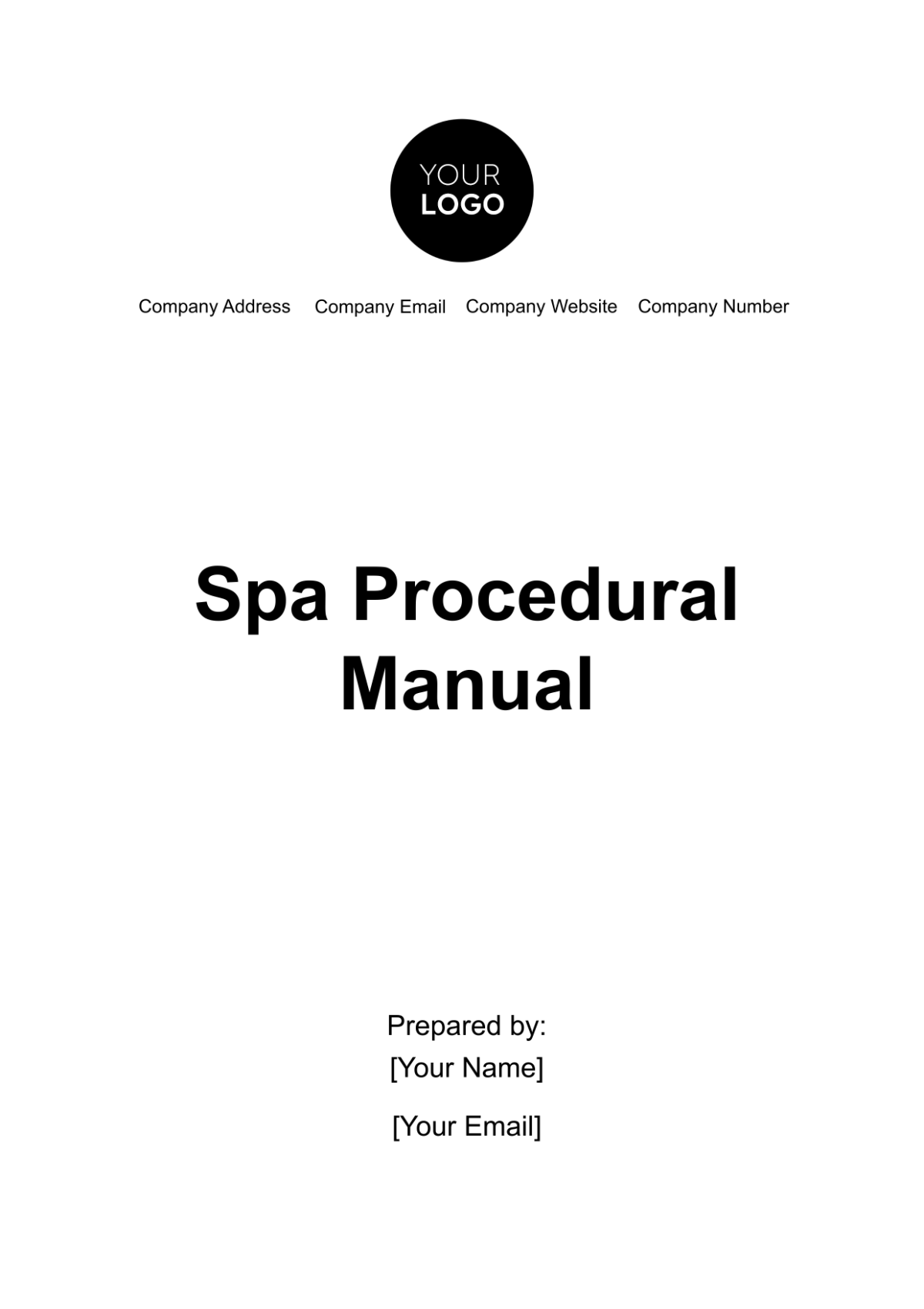Accounting Policy & Procedure Manual
TABLE OF CONTENTS
Introduction.............................................................................................................3
Objective..................................................................................................................4
Scope and Applicability...........................................................................................5
Key Accounting Principles.......................................................................................6
Accounting Policies..................................................................................................7
Accounting Procedures............................................................................................8
Responsibilities.........................................................................................................9
Internal Controls and Audit Compliance.................................................................10
Financial Analysis and Reporting.............................................................................11
Conclusion..................................................................................................................12
Introduction
This manual serves as an essential tool for our team, providing a structured approach to our financial operations. The manual is crafted to offer clarity and direction in our accounting practices, ensuring that all financial activities are conducted with the highest standards of transparency and accuracy. By adhering to the guidelines set forth in this manual, we aim to achieve exemplary financial management, fostering the growth and stability of our organization.
Objective
The primary objective of this manual is to delineate a robust framework for accounts policy and procedures within [Your Company Name]. It aims to establish transparent, concise, and uniformly applicable accounting processes, fostering an environment of financial integrity and accountability. This manual is designed to be a cornerstone resource, guiding staff in maintaining accurate and consistent financial records, thereby ensuring the reliability of financial reporting and compliance with applicable laws and regulations.
Scope and Applicability
This manual is universally applicable across all financial activities and transactions within [Your Company Name]. It serves as a guide for employees involved in financial operations, encompassing the procedures for processing transactions, making informed financial decisions, and the accurate preparation of financial statements. The guidelines within this document are intended to standardize accounting practices across the organization, thereby facilitating a consistent approach to financial management and reporting.
Key Accounting Principles
The accounting practices at [Your Company Name] are governed by key principles that ensure the accuracy, reliability, and transparency of our financial reporting. These principles are foundational to our accounting framework and are rigorously applied in our financial processes:
Accrual Basis Accounting:
Recognition of Revenues and Expenses: In accordance with the accrual basis of accounting, we recognize revenues when they are earned and expenses when they are incurred, irrespective of the actual cash flow. This approach provides a more accurate representation of the company's financial performance and position during a specific period.
Enhancing Financial Clarity: This method allows for a clearer understanding of the financial outcomes of our operations, as it matches revenues to the periods in which they are generated and aligns expenses with the corresponding revenues.
Consistency Principle:
Uniform Application of Accounting Methods: We adhere to the consistency principle by applying the same accounting methods and policies from one financial period to the next. This consistency facilitates meaningful comparison of financial statements over time.
Transparency and Comparability: The consistent use of accounting treatments enhances the transparency of our financial reporting and enables stakeholders to compare financial data across different periods effectively.
Prudence Principle:
Realistic Financial Representation: The prudence principle guides us to exercise caution in our financial reporting, ensuring that we present a realistic view of the company's financial situation. This involves avoiding the overstatement of income or assets and the understatement of expenses or liabilities.
Conservative Financial Estimations: We adopt a conservative approach in making estimations and judgments required in financial reporting, which ensures that the financial statements are free from significant misstatements and provide a true and fair view of the company's financial position.
These principles are guidelines that are integral to the ethical and professional conduct of our accounting practices at [Your Company Name]. They underpin our commitment to delivering high-quality financial information that stakeholders can rely upon for informed decision-making.
Accounting Policies
The accounting policies outlined herein are fundamental to the financial operations of [Your Company Name], ensuring adherence to the highest standards of accounting principles and practices.
Revenue Recognition Policy:
At [Your Company Name], we adhere to a stringent revenue recognition policy that aligns with both Generally Accepted Accounting Principles (GAAP) and International Financial Reporting Standards (IFRS). Revenue is recognized when the control of goods has been transferred or services have been rendered to the customer, reflecting the completion of a sales transaction. This policy ensures that revenue is recorded accurately in the period it is earned, thereby providing a true and fair view of the company's financial performance.
Expense Recognition Policy:
Our expense recognition policy is governed by the matching principle, a cornerstone of accrual accounting. Expenses are systematically matched with the revenues they help generate, within the same accounting period. This policy is pivotal in ensuring that each reporting period accurately reflects the true costs incurred in generating revenues, thereby providing a comprehensive view of the company's financial health and operational efficiency.
Fixed Assets Depreciation Policy:
The depreciation of fixed assets at [Your Company Name] is handled through the straight-line method. This approach involves evenly spreading the cost of an asset over its estimated useful life. By adopting this method, we ensure a consistent and systematic charge to expense over the asset's life, reflecting the usage and economic benefit derived from the asset. This policy not only aligns with standard accounting practices but also aids in the clear representation of asset value and depreciation expense on our financial statements.
These policies are fundamental to maintaining the integrity and consistency of [Your Company Name]'s financial records. They are designed to comply with regulatory requirements and reflect the company's commitment to financial transparency and accountability.
Accounting Procedures
The procedures detailed in this section constitute the foundation of our day-to-day accounting operations at [Your Company Name]. They provide a structured, step-by-step approach to ensure consistent execution of our accounting policies, thereby enhancing accuracy and reliability in our financial reporting.
Invoice Processing:
Invoice Receipt: On receiving an invoice, it is immediately date-stamped and logged into our accounting system.
Verification and Approval: Each invoice is scrutinized for accuracy, with details such as amounts, terms, and vendor information verified against purchase orders and delivery receipts. Approval is then sought from the relevant department head.
Account Allocation and Entry: Approved invoices are coded to the correct general ledger account and entered into the accounting system.
Payment Scheduling and Processing: Invoices are then scheduled for payment based on their terms, and payments are processed accordingly, ensuring timely settlements and maintaining healthy vendor relationships.
Sample of Invoice Receipt:
Invoice ID:
00123
Vendor Name:
Date Received:
Amount:
Purchase Order Number:
Approval Status:
Payment Due Date:
Payment Status:
Bank Reconciliation:
Daily Transaction Review: Transactions are reviewed daily for any discrepancies between the bank statements and the company’s records.
Identifying and Rectifying Discrepancies: Any differences are investigated and rectified promptly. This could involve adjusting journal entries for bank fees, interest income, or errors in recording transactions.
Final Reconciliation and Approval: The reconciliation process is finalized at the end of each month, and the reconciled statement is reviewed and approved by the designated finance officer.
Sample of Bank Reconciliation:
Date:
[Month Day, Year]
Ledger Balance:
Bank Statement Balance:
Discrepancy:
Notes:
Payroll Processing:
Timekeeping and Payroll Calculation: Employee hours are accurately recorded and verified. Payroll is then calculated, including deductions and withholdings for taxes and benefits.
Payroll Review and Approval: The calculated payroll is reviewed for accuracy and approved by the designated authority.
Disbursement and Reporting: Salaries are disbursed to employees, and necessary payroll reports are generated and filed with relevant government agencies.
Sample of Payroll Receipt:
Employee ID:
E-1001
Name:
Hours Worked:
Gross Pay:
Deductions:
Net Pay:
Pay Date:
Purchasing and Expense Claiming:
Purchase Authorization: All purchases are initiated with a requisition and require authorization from the designated authority.
Receipt and Verification of Goods or Services: Upon receipt of goods or completion of services, the corresponding documentation is checked for consistency with the purchase order.
Expense Claim Submission and Verification: Employees submit expense claims with the required receipts and documentation. Claims are then verified for compliance with the company’s expense policy.
Reimbursement Processing: Approved claims are processed for reimbursement, ensuring timely and accurate compensation to employees for their out-of-pocket expenses.
Sample of Purchase and Expense Slip:
Claim ID:
C-201
Employee Name:
Date Submitted:
Description:
Amount:
Approved Amount:
Status:
These procedures are designed to ensure the efficient and effective execution of our accounting tasks, upholding the principles of accuracy, transparency, and accountability in our financial dealings. They are integral to maintaining the financial integrity of [Your Company Name] and are subject to periodic review and updates to align with evolving best practices and regulatory requirements.
Responsibilities
The adherence to the accounting policies and procedures outlined in this manual is a collective responsibility, essential for maintaining the financial integrity of [Your Company Name]. To ensure effective implementation and oversight, specific roles and responsibilities are delineated within the accounting function:
Chief Financial Officer (CFO):
Strategic Financial Leadership: The CFO is responsible for providing the overall strategic direction for the finance function, aligning it with the company's broader business goals.
Compliance and Ethical Oversight: They ensure adherence to legal and regulatory requirements, fostering an environment of ethical financial practices.
Financial Risk Management: The CFO oversees the company's financial risk management policies, ensuring that financial risks are identified, monitored, and mitigated effectively.
Accounting Manager:
Operational Management: The Accounting Manager manages the day-to-day operations of the accounting department, ensuring that all financial transactions are accurately recorded and processed in a timely manner.
Internal Controls and Procedures: They are responsible for the implementation and maintenance of effective internal controls and accounting procedures.
Financial Reporting and Analysis: The Accounting Manager ensures the accuracy and integrity of the company’s financial reports and conducts analyses to provide insights for informed decision-making.
Accountants:
Transactional Processing and Entry: Accountants are responsible for the routine processing and entry of financial transactions into the accounting system, ensuring accuracy and compliance with established policies.
Financial Reporting: They assist in the preparation of financial statements and reports, providing detailed, accurate, and timely financial information.
Data Management and Reconciliation: Accountants manage and reconcile financial data, ensuring the integrity and reliability of financial information.
These roles, while distinct in their specific responsibilities, work collaboratively to ensure the smooth functioning of [Your Company Name]'s financial operations. Each position plays a vital role in upholding the financial standards set forth in this manual, contributing to the overall financial health and success of the organization.
Internal Controls and Audit Compliance
The purpose of this section is to outline the internal controls and audit compliance procedures at [Your Company Name]. These controls are designed to safeguard the company's assets, ensure the integrity and accuracy of accounting information, and promote operational efficiency.
Establishment of Internal Controls:
Comprehensive Risk Assessment: We conduct thorough and periodic assessments to identify, analyze, and manage risks that could impact the financial reporting process. This proactive approach helps in anticipating and mitigating potential disruptions to financial integrity.
Robust Control Activities: We implement a range of control activities, including checks and balances, authorization protocols, and verification procedures. These activities are tailored to address the specific risks identified and ensure the reliability and accuracy of the company's financial reporting.
Segregation of Duties:
Strategic Division of Responsibilities: To minimize the risk of errors or fraudulent activities, we systematically divide critical functions such as authorization, custody of assets, and record-keeping among various staff members. This segregation serves as a vital check and balance within our financial system.
Cross-Functional Checks and Reviews: Regular, cross-departmental reviews are conducted to ensure comprehensive compliance with financial policies and procedures. This approach helps in identifying and rectifying any potential control weaknesses across different functions.
Documentation and Record Keeping:
Record Maintenance: We maintain detailed, organized, and accurate records of all financial transactions and supporting documents. This practice is crucial for transparency and accountability in financial reporting.
Systematic Access and Retrieval: Financial records are stored in a manner that facilitates easy and timely access for review, analysis, and auditing purposes, ensuring efficiency and responsiveness in financial management.
Regular Financial Audits:
Diligent Internal Audits: Periodic internal audits are conducted to rigorously assess the effectiveness of internal controls and the adherence to established policies and procedures. These audits are instrumental in identifying areas for improvement and enhancing financial governance.
Independent External Audits: We engage with external auditors annually to independently validate the accuracy and completeness of our financial statements. These external audits are essential for ensuring compliance with external regulatory requirements and enhancing stakeholder confidence.
Audit Compliance:
Proactive Audit Preparation: We prepare diligently for audits by ensuring that all financial records are current, orderly, and accurately reflect the company’s financial position.
Responsive Audit Findings Management: We promptly address any findings or recommendations from audits, implementing corrective actions swiftly to rectify any identified deficiencies.
Continuous Improvement:
Adaptive Review and Enhancement: We are committed to the ongoing review and refinement of our internal controls and audit compliance procedures. This commitment ensures that our practices remain relevant and effective, adapting to changes in the business environment, technological advancements, and regulatory standards.
This section emphasizes the importance of robust internal controls and audit compliance in maintaining the financial integrity and accountability of [Your Company Name]. It ensures that all employees are aware of their roles in these processes and contributes to the overall effectiveness and reliability of our financial operations.
Financial Analysis and Reporting
This section focuses on the procedures and standards for financial analysis and reporting at [Your Company Name]. The aim is to ensure that financial data is accurately interpreted and reported, providing meaningful insights for strategic decision-making and external communication.
Financial Analysis Framework:
Data Collection and Validation: Regular collection and validation of financial data to ensure accuracy and relevance.
Analytical Techniques: Utilization of various analytical techniques, including ratio analysis, trend analysis, and variance analysis, to interpret financial data effectively.
Performance Metrics: Identification and monitoring of key financial performance indicators to assess the company's financial health and operational efficiency.
Financial Reporting Standards:
Compliance with Reporting Standards: Adherence to Generally Accepted Accounting Principles (GAAP), International Financial Reporting Standards (IFRS), and other relevant financial reporting standards.
Timely and Accurate Reporting: Ensuring that all financial reports are prepared and disseminated in a timely and accurate manner, meeting internal management needs and external regulatory deadlines.
Management Reporting and Decision Support:
Customized Management Reports: Creation of tailored management reports that provide critical financial insights for strategic planning and decision-making.
Budgetary Control and Forecasting: Utilization of financial reports for effective budgetary control and financial forecasting, aiding in resource allocation and future planning.
External Financial Communication:
Investor Relations: Preparation of financial statements and reports for shareholders and potential investors, highlighting the company's financial performance and prospects.
Regulatory Reporting: Ensuring that all statutory and regulatory financial reporting requirements are met, maintaining transparency and compliance with financial authorities.
Financial Reporting Software and Tools:
Technological Integration: Leveraging advanced financial reporting software and tools to enhance the efficiency, accuracy, and security of financial data processing and reporting.
Continuous Training and Development: Providing ongoing training for staff on the latest financial software and reporting tools to keep pace with technological advancements and industry best practices.
By establishing robust procedures for financial analysis and reporting, [Your Company Name] is equipped to deliver insightful, accurate, and timely financial information. This plays a pivotal role in informing strategic business decisions, fulfilling regulatory obligations, and communicating financial performance to stakeholders.
Conclusion
Throughout the manual, you will find further descriptions and guidelines for each accounting principle, policy, procedures, and role clarified in their respective sections. Changes and updates to this manual are made regularly to drive accurate and efficient financial operations.

















































